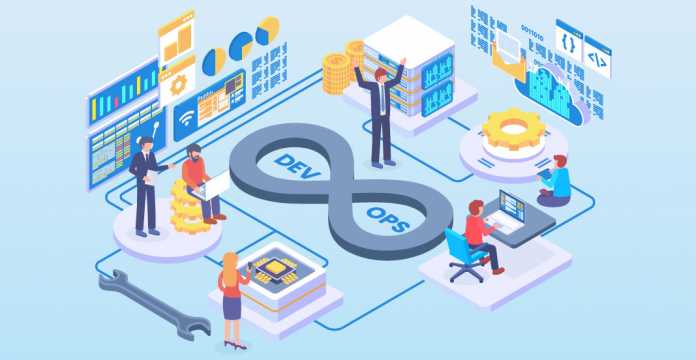
Internet, connectivity and software technologies have boosted client’s expectations for service production, security and feature. And, considering almost every company is a software organization, businesses are required to react quicker than ever before when it comes to developing product features, making issues, delivering customer service or even to market engagement and courses.
Organizations have responded by adopting modern Software Development Lifecycle (SDLC) approaches such as DevOps that streamline the organizational, method and tooling workflows to promote quality software changes to end-users faster and efficiently. Fast reply to client requirements often begins with killing the process bottlenecks and substituting manual tasks with mechanization. The resulting activity and speed help organizations align every level of the SDLC workflow with business goals in the context of increasing end-user and market requirements.
Enabling Standardization in DevOps
As growing business organizations improve software products from the view of the customer or end-user experience, developers need to operate their way backwards in identifying customer requirements and presenting relevant results. Different customer needs, variable market trends, rigorous compliance requirements and internal business goals open too numerous variables for developers to follow during the SDLC pipeline. This means that all steps of the SDLC offer several variables to study, each with its individual technical and business territories. This type bottlenecks the software development production as different SDLC teams have no logical workflows to support and end up in pits.
To approach this test, DevOps teams must utilize improved workflows, processes, technologies, customs and metrics. This decreases the variety, and the associated risks, and enhances the potential for automating otherwise standard methods. In various ways, standardization can be viewed as the essential enabler to industrialization and hence it has a vital task in the automation plans of a DevOps organization.
At the same time, DevOps organizations also need to have a delicate balance between uniformity and flexibility, particularly when it comes to the tooling. DevOps is continuously growing, and every organization can have a kind of DevOps workflows, policies and implementations. The tooling standardized now could be harmful to innovation undertaken by new or alternate technologies possible in the industry.
However, the idea of automation in DevOps, embracing the approach of standardization, also applies to the governance models compared with the unification of tooling, among other aspects. Specific mechanisms should be in place to promote the adoption of new technologies that limit employees from using shadow IT practices, which in turn produce pits between teams. For example, creating a library of tools that can be requested, vetted and made possible as needed can assist organizations in preparing for the changes compared with using new tools and yet have standardized DevOps workflows.
Considering the broader view of the DevOps landscape, organizations must acknowledge the role of self-regulation not just as explaining the technology pile as executable, but also as the capacity to reduce performance bottlenecks, information gaps and silos between Devs, Ops and QA, as well as tools that facilitate agility through standardized SDLC process.
The role of automation continues to the following critical duties from the DevOps SDLC:
- Code Development: Self-regulation in applications such as source control enable developers to keep on top of the DevOps SDLC pipeline. For example, setting specific modifications to the build and triggering appropriate changes or process activities save present and simplify the development of healthy, complex software projects.
- Visibility: Ops organizations can remain on top of the code modifications, existing problems and the resulting influence on project goals by automating traceability and the issue following methods. Devs and QA need to cooperate within and over teams to ensure that the SDLC process runs efficiently. For instance, if a protection team member recognizes code issues weeks after it was presented, Devs already have a provocation at their hand to revenge the root cause without delaying or losing the progress made since. An uncomfortable feedback circle between Devs, QA and Ops, is required to reduce pits and bottlenecks within the teams.
- Continuous Testing: Automation is crucial to maintain, execute and manage constant testing in DevOps settings. Since testing in DevOps structures is done regularly during the SDLC pipeline, Devs and QA must also handle the requirements of a perpetual testing environment. These range from triggering automated communications among systems and team members, integrating multiple tests, tracing and predicting issues, and promoting continuous integration of approved automated builds.
- Enabling CI/CD: Automation in the Constant Integration and Continuous Delivery pipeline guarantees that suitable software builds, data, tests and code modifications are passed to appropriate target environments. DevOps teams can, therefore, make numerous code changes, stage the builds for testing and finally push frequent software modifications to the market.
- Monitoring and Incident Management: The length and metrics of significant data creation can be overwhelming for companies with the infrastructure of all dimensions and scale. Instead of moving through the plenty of alerts, a high-level incident recording is required to make sense of support performance and likely issues. Automation, therefore, becomes essential to prioritize events intelligently, identify the root cause and deliver proactive actionable intelligence. To enable real DevOps, IT Ops might often need to follow antiquated IT service assurance procedures with automation skills and software-defined IT Ops, among other automation procedures.
Striking the Balance
It’s necessary to understand that DevOps is not all about tooling. The concept of automation in DevOps is meant to facilitate agility and active collaboration between all members of the DevOps organization. While it makes sense to automate the repeatable tasks that otherwise need manual efforts, it also occurs with the consequence of repeating and expediting the results of those tasks, sometimes as automation waste. So if a process is flawed, the effect through automation is consequently, imperfect, and emerges faster than the standard approach. Secondly, automating processes in legacy conditions may lead to additional difficulties that tend to reduce the returns on automation investments and capabilities.
Automation is best applied only after eliminating the bottlenecks and poor designs that lead to automation loss. The centre purpose of DevOps is to deliver software builds at better quality with higher frequency. Automation in DevOps should be embraced to realize this goal, without introducing a net negative effect on the quality or rate of software released to end-users.














